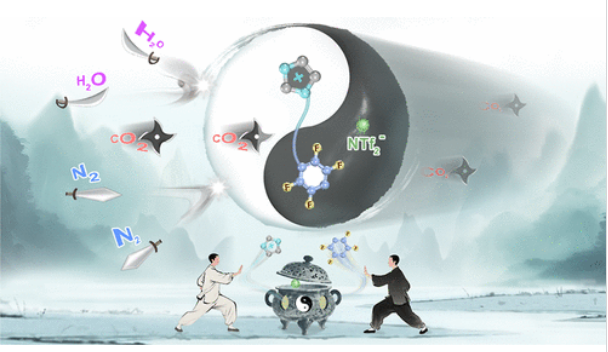
武汉工程大学易群团队实现了金属-有机框架上离子疏水门从潮湿烟气中分离高纯度二氧化碳。这一研究成果于2025年7月7日发表在国际顶尖学术期刊《美国化学会杂志》上。
通过吸附分离从潮湿烟气中高效提取高纯度二氧化碳,为碳减排和下游应用提供了一个有前途和可持续的解决方案。然而,潮湿烟气中H2O蒸汽和N2的共吸附仍然是限制分离效率的持续挑战。
为了克服这一问题,研究组在多孔吸附剂上引入了离子疏水门的新概念,使高纯度二氧化碳直接从潮湿的烟气中一步分离。通过将疏水离子液体和富氟对苯二甲酸乙二醛组装到金属有机框架(MOF)的表面,该设计在外壳上建立了H2O屏障和CO2通道,同时保持了核心的孔隙完整性。所制备的核壳材料具有优异的CO2吸附能力,CO2/N2选择性高达1780 (15/85,v/v),优于传统吸附剂。值得注意的是,在一次突破性实验中,他们从潮湿烟气(相对湿度,RH = 100%)中成功地提取了纯度为99.999%的干二氧化碳。
原位漫反射傅里叶变换红外光谱(in situ DRIFTS)和密度泛函理论计算表明,富氟疏水位点可形成有效的水分子屏障,而离子液体片段通过氢键和静电相互作用促进CO2的运输。由于其优异的可扩展性和与各种MOF平台的广泛兼容性,这种离子疏水门控策略为构建先进的气体分离材料提供了一种灵活的方法,在碳捕获,清洁能源和可持续化学过程中的工业应用前景广阔。
附:英文原文
Title: Ionic Hydrophobic Gates on Metal–Organic Frameworks Enable High-Purity CO2 Separation from Humid Flue Gas
Author: Deyun Sun, Shangqing Chen, Miao He, Hongxue Xu, Yongxiang Sun, Lijuan Shi, Hongbo Zeng, Qun Yi
Issue&Volume: July 7, 2025
Abstract: Efficient extraction of high-purity CO2 from humid flue gas via adsorptive separation offers a promising and sustainable solution for carbon reduction and downstream applications. However, the coadsorption of H2O vapor and N2 from humid flue gas remains a persistent challenge that limits separation efficiency. To overcome this issue, this work introduces a novel concept of ionic hydrophobic gates on porous adsorbents, which enables one-step separation of high-purity CO2 directly from humid flue gas. By assembling hydrophobic ionic liquids and fluorine-rich terephthalaldehyde onto the surface of a metal–organic framework (MOF), this design establishes H2O barriers and CO2 channels on the outer shell while maintaining pore integrity in the core. The resulting core–shell material demonstrates exceptional CO2 adsorption capacity and an extraordinary CO2/N2 selectivity of 1780 (15/85, v/v), surpassing conventional adsorbents. Notably, dry CO2 with 99.999% purity is successfully extracted from humid flue gas (relative humidity, RH = 100%) in a single breakthrough experiment. In situ diffuse reflectance Fourier transform infrared spectroscopy (in situ DRIFTS) and density functional theory calculations reveal that fluorine-rich hydrophobic sites act as effective H2O barriers, while ionic liquid segments facilitate the transport of CO2 through hydrogen bonding and electrostatic interactions. Owing to its excellent scalability and broad compatibility with diverse MOF platforms, this ionic hydrophobic gating strategy offers a robust and versatile approach for constructing advanced gas separation materials, holding great promise for industrial applications in carbon capture, clean energy, and sustainable chemical processes.
DOI: 10.1021/jacs.5c02093
Source: https://pubs.acs.org/doi/abs/10.1021/jacs.5c02093
JACS:《美国化学会志》,创刊于1879年。隶属于美国化学会,最新IF:16.383
官方网址:https://pubs.acs.org/journal/jacsat
投稿链接:https://acsparagonplus.acs.org/psweb/loginForm?code=1000
